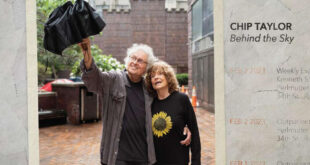A beautifully staged modern vision of Alessandro Stradella’s 1681 oratorio La Susana was at BAM this weekend after a brief run in Washington DC. Though based on a biblical story and composed in baroque style, this impactful work rings thuddingly into our century and the age of #MeToo.
With elements of prurience and scandal and a theme of divine justice, the tale has been a favorite of artists since the Renaissance: Tintoretto, Rubens, Rembrandt, Gentileschi, even Picasso. But it’s much more than an image of two men leering at a naked woman. Librettist Giovanni Battista Giardini saw it through the lens of his own times, and Stradella set Giardini’s words to some of the period’s most gorgeous music.
For their new realization, performed in Italian with English supertitles, co-producers Heartbeat Opera and period-instrument company Opera Lafayette frame the story, which derives from the Book of Daniel, in the halls of academe. The reimagine Giardini’s narrator Testo as a female professor, who presents the story.
Two Judges, respected elders among the Israelites, lust for Susana, the virtuous wife of Joachim. Spying her bathing, they harass her cruelly. Rebuffed, they accuse her of infidelity and sentence her to death. At the last moment, the prophet Daniel intercedes, demonstrating the Judges’ mendacity and redirecting the ultimate punishment their way. Scholarly Testo offers commentary along the way, sung here by contralto Sara Couden with dark, rich tonality and a knowing, sober mien.
Her (fictitious) talk bears the aggressively academic title “Objectifying Susana, Undermining Patriarchy.” To begin, she unveils a life-sized white statue of a nude woman, carved in Monumentalist style. The superb six-piece band plays an introductory fugue and other short pieces with beautiful tone and exquisite timing. For a lover of baroque music, the musicians’ performances throughout the production are a joy.
The gauzy curtain is pulled aside to reveal Reid Thompson’s simple, lovely set. Flanking a pearl-white tub that resembles an enormous baptismal font are realistically carved white statues of a priest, a soldier, and a man in a suit whom I imagine represents a merchant. The first Judge enters and sings of his lust for the as-yet unnamed Susana. Bass-baritone Paul Max Tipton’s well-modulated approach aptly suggests the constrained fire, the “fever in my heart.” The second Judge, sung by velvet-voiced tenor Patrick Kilbride, adds his voice. They lace their simpatico duet with red-gloved gesturing – jollity before the trauma.
Soon enough, they spy Susana, and the harassment begins. Lighting designer Oliver Watson assists the psychological action with baths of lurid color. The scholar uses her laser pointer to stress the supertitle reading “Great goodness and great beauty justify the desire to possess,” literally pointing out how sexual dynamics have changed so little since Stradella and Giardini’s time and indeed since biblical times.
Lucía Martín Cartón is a marvel as Susana. Her multi-hued soprano shifts from joyous to plaintive, wretched to resigned. She sings eloquently whether she’s standing, luxuriating in the tub, or crouching in misery in a prison cell. She’s a terrifically expressive actor, with subtle agility in face and form. Reveling innocently in the bath, beautifully costumed thanks to Beth Goldenberg, she’s captivating enough. But it’s her later aria of lamentation from prison, displaying beautiful tonal and dynamic control and vivid emotionality even from a crouch, that drew spontaneous and inevitable applause.
Just as Susana is about to face the music, a previously unassuming character, sung by soprano Ariana Douglas, transforms from a modern-day student into Daniel. She does so without discarding her modern clothes (save for kindly lending forlorn Susana her leather jacket). This small touch further suggests the continuity of the story’s theme.
The Prophet’s neat delivery of the Judges’ comeuppance feels a little anticlimactic after the sensitively depicted drama and wonderful music that preceded. But we have to remember that La Susana wasn’t written to be staged. The program explains that it was meant for Lent, when opera was forbidden in Italy and only religious-themed oratorios could be performed.
Fortunately for us, the creative minds of two modern-day opera companies have focussed equally on the past and the present to devise a superb production. It revives wonderful, rarely-heard music and tells an old, forever-new story with love, humor, and seductive grace.
A textual note: If you know something of the Bible but aren’t familiar with the story of Susana, you’re not alone. Before seeing this production I searched in vain for her in the Book of Daniel. None of the three Bibles I own contains the story: not the Jewish Old Testament, nor the King James, nor the scholarly New Oxford Annotated Bible with Apocrypha I studied from in college. It turns out that Chapter 13 of the Book of Daniel, with the tale of Susanna (as it’s typically spelled in English) and the Elders, is only in Catholic and Orthodox Bibles.
 Blogcritics The critical lens on today's culture & entertainment
Blogcritics The critical lens on today's culture & entertainment




